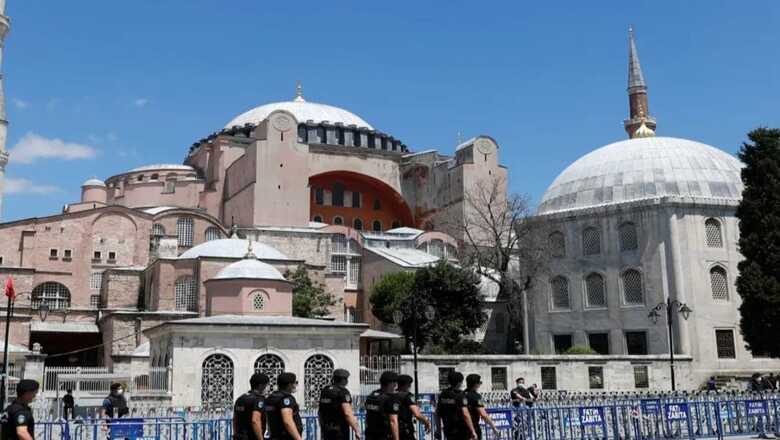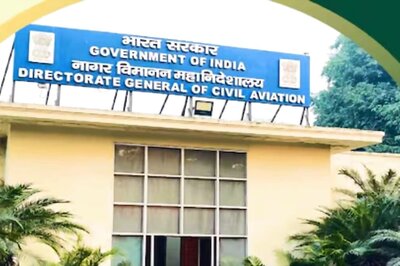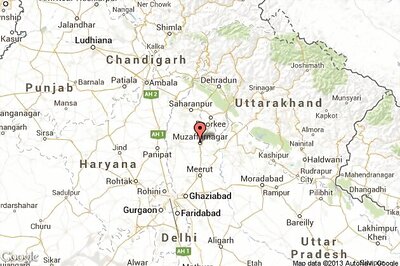
views
A claim persists that Istanbul’s iconic Hagia Sophia went from church to mosque not through conquest but through a generous sultan’s magnanimity and that it was not usurpation but a fair-and-square real estate deal.
The claim isn’t new but has surfaced once again in light of the temple consecration in Ayodhya. The motivation is evident—to neutralise the parallels drawn between the two highly contested structures’ journeys. But do historical records bear out the claim?
Though interesting, it is complicated by the fact that the propagators of this claim rarely, if ever, offer any evidence in its support. In the absence of any such source, the investigation becomes remarkably harder. But that doesn’t mean it can’t be done. Only it’ll take a tad longer than otherwise.
We will examine three tertiary, one secondary, and three primary sources; one of them is an eyewitness account. This should be a fair distribution. Ideally, one would eschew anything that isn’t primary, but some accounts, despite their tertiary character, hold immense value owing to their authors’ subject-matter authority. With that preamble out of the way, a quick primer on the structure in question.
Hagia Sophia rose in the city of Constantinople as the ecclesiastical centre of the Eastern Roman Empire, colloquially referred to as Byzantium, shortly after the fall of Rome in the middle of the first millennium AD.
The latter refers to the Western Roman Empire. After about a thousand-year run, Constantinople fell to the Ottomans, following which Sultan Mehmet converted several churches to mosques, including Hagia Sophia. This event is called the Fall of Constantinople.
The Fall of Constantinople 1453
Our first exhibit is a work by Sir James Cochran Stevenson Runciman, or Steven Runciman for short. To anyone who digs into Byzantine history, the name should most certainly ring a bell, for so far as authority on the subject goes, Runciman is widely acknowledged as an ultimate. He is best known for his three-volume work on the Crusades, but it’s his work on Constantinople’s conquest that we’re interested in here.
1453 is the year the city fell after a protracted siege. In the month of May, to be precise. Hagia Sophia was then the largest ecclesiastical building on Earth, with the Titanic Basilica of the Vatican still half a century away. As was commonplace in those days, the conquest involved much carnage and pillage.
Runciman informs us that the Ottomans, in keeping with a longstanding Islamic tradition, allowed their soldiers three days of unchecked pillage immediately upon a successful conquest.
During that window, they could loot, plunder, destroy, enslave, and kill at will. Whatever they could loot was theirs. Needless to say, this is the fate that befell Constantinople too.
While not much is known of what happened to most churches in the city, Runciman lists four whose fates are on record. Among them is Hagia Sofia. Unambiguously, he affirms that it was converted into a mosque, and its bishop, also the Patriarch of Constantinople, Gennadius, was taken prisoner. We will circle back to this character a little later. For now, suffice it to note that Runciman’s book makes no mention of any real-estate transaction whatsoever. It makes copious mention of sacking, burning, rape, and plunder, but none of a church being purchased by the Ottomans.
While taking Runciman’s word as final, given his stature, isn’t such a terrible idea, we’ll continue with other sources. As they say, absence of evidence isn’t necessarily evidence of absence.
An Imperial Commission
The work is titled “Aya Sofia, Constantinople, as recently restored by order of H M the sultan Abdul Medjid.” As the name suggests, it’s a detailed architectural exposition of Aya Sofia (Turkish for Hagia Sophia) commissioned by the Ottoman emperor Abdulmejid I. He’s best known as one of the sultans who presided over the beginning of the caliphate’s decline.
While being a nineteenth-century work, it’s as tertiary as it gets, and its status as an imperial project makes it worth examination. Interestingly, it’s not in Turkish but in French, a language not uncommon in the country. While the book is about architecture, its opening chapter offers a decent insight into its history by way of introduction. It’s titled “Ste. Sophie,” a reference to the Church of Saint Sophia or Hagia Sophia (Hagia Sophia, by the way, is Greek for Holy Wisdom).
In this intro, on the very first page, there’s a mention of the structure’s conversion to a mosque towards the end of 1453. That’s about five months or so after the fall. What transpired in those months, it doesn’t say anything.
Most importantly, there is no mention of a purchase. It even details how the Sultan ordered a fresh coat of paint to hide all Christian art painted on its walls. But why no mention of the purchase? An imperial document would surely see no merit in concealing such an upright act that showcases nothing but its Sultan’s magnanimity, would it?
The Endowment Deed of Mehmed ‘the Conqueror’
Royals make endowments to religious bodies all the time. This earns them doctrinal legitimacy, especially in a highly orthodox medieval society where blurring the line between State and religion had direct material incentives—a rather pragmatic arrangement of shared sovereignty if you will. This practice featured in polities all over the world, from India to Europe and, of course, the Muslim world.
Therefore, when Mehmet acquired Constantinople, and the Church with it, a similar endowment followed. This was recorded in, as was the norm, a deed—it is called Fatih Sultan Mehmed Vakfiyesi or The Endowment Deed of Mehmed the Conqueror. If the acquisition was the result of a financial transaction, this is where one would expect to find it mentioned. Besides any other document more specific to the transaction, that is. The document is currently held in the archives of the General Directorate of Land Registry and Cadastre.
The original document is in the Arabic script, which is how they wrote Turkish in those days. More recently, someone transcribed it into the modern Latin script which enables us non-Turks to read it with a little help from online translation services. And when we do, what do we find? Only one mention of the Hagia Sophia as a church, one among many that the Ottoman Sultan found upon visiting the sacked city after the conquest.
The verb used is bulunan which Google wrongly translates as “made foundation” instead of “found,” which may give the impression that he built many churches when he actually just found them. Then, records the deed, he took its possession as a divine reward for jihad in accordance with the Shariʿa.
In the same page, the document then speaks of a qibla and an imam in the context of Hagia Sophia. In case there still remains any confusion, all subsequent references are to a Hagia Sophia Mosque and not a Church.
In the entire document, there isn’t one mention of any purchase. Wonder why a deal of this significance and quantum would be skipped over in a paper that documents all other aspects of the conquest and conversion.
Historians of the Fall
Among the primary sources of the event, collectively called the Historians of the Fall, only one happens to be an eyewitness—George Sphrantzes. A Byzantine historian and courtier at Constantinople, Sphrantzes was still in the city when the siege fell and the city was sacked. He penned his experiences through the war and his subsequent flight to Morea in Chronicon Minus or Minor Chronicle.
The work does not say much about the fall and makes no mention of Hagia Sophia whatsoever. Perhaps because he was captured and enslaved immediately upon the fall and the conversion came months later. As soon as he was freed, about four months later, he fled Anatolia. This doesn’t leave it very useful to our discussion here, but the work forms the core of yet another which is.
Decades after Sphrantzes, a Greek historian named Makarios Melissenos endeavoured to expand his work with more insights. Melissenos lived a couple of decades after the Fall which makes his writing a secondary source. But dismissing it would be unwise for a reason we’ll discuss in a bit. First, let’s get to our final primary source, the only one in Latin.
‘Body of Byzantine History Writings’
Doukas (yes, we don’t know his first name) was of a Hellenic stock but was native to Anatolia, not uncommon for the time. He is best known for his Corpus Scriptorum Historiae Byzantinae or “Body of Byzantine History Writings,” a work of great industry that narrates the history of the region through the siege and the conquest. One reason Doukas is significant is because he’s the only one on our list who could speak both Turkish and Latin. Thus, he was able to draw from both Ottoman and Genoese sources in his narration. Which is why despite his Greek identity, his work is in Latin.
So what does he say about Hagia Sophia? A lot more than Sphrantzes did for sure. He categorically confirms the conversion of the structure—which he refers to as S. Sophiam, Latin for Saint Sophia—into a meschitam or mosque. Interestingly though, he mentions no Patriarch, much less a deal. With no Patriarch and the emperor dead, who signed away the church for Rome? Again, had there been a purchase, Mehmet would have made it as public as it gets to establish his image as a righteous conqueror. And had something like that been public, surely it wouldn’t have escaped the work of a historian who happened to be present in the city at the time.
Hagia Sophia Museum
Our solitary tertiary source happens to be a website (https://muze.gen.tr/muze-detay/ayasofya). Sure, that’s too modern, too removed from the event in question, but the fact that the website belongs to none other than the Hagia Sophia Museum does accord it a measure of authority, wouldn’t we agree? If something as monumental as a royal purchase took place, surely it would find at least a fleeting reference here? Especially in a section that discusses the very conversion the sale allegedly facilitated. Unfortunately, no such mention.
“When Sultan Mehmet the Conqueror conquered the Konstantiniyye,” says the website, “he converted it into his imperial mosque.” No sale. From that point on, the whole discussion is about the modifications made to the structure to lend it a new Islamic character.
‘Major Chronicle’
And now we can finally return to Melissenos, the Greek contemporary we left behind while discussing George Sphrantzes. As we already noted, Melissenos did not produce anything independently but instead, built upon that of Sphrantzes, adding a whole lot of missing insights to it. These additional insights were possible only because he was able to draw on more sources than one, thanks to his proficiency in both Latin and Turkish. That’s why his work is titled Chronicon Maius or “Major Chronicle”.
While Melissenos wasn’t exactly a contemporary of Sphrantzes or the Fall, his work is perhaps the most important of all despite its secondary nature. More so than even the primary ones. Because it’s the only source of the purchase narrative.
Being a Greek, Melissenos is naturally far from charitable of Ottomans in general and Mehmet in particular. But that doesn’t make him any less useful. The Patriarch who was missing from Sphrantzes’ work, finally makes an appearance in Melissenos’. In fact, this is the only source from the time that mentions him.
So the story goes that Mehmet, on his maiden visit to the sacked city, invited Gennadius to a private dinner where the two had a long conversation. What transpired over dinner is not public knowledge but when the Patriarch emerged, he was carrying a very expensive crozier and being ushered by the Sultan to a horse awaiting him at the gates.
A crozier, also known as bishop’s staff, is a sigil of ecclesiastical office. Even today, the Pope carries one. But office of what? One would think Hagia Sophia, of course, considering he was the Patriarch of the city. But no, the horseback ride was a one-way trip to the Church of the Holy Apostles where he’d remain until being eventually deposed from there too. Why the change? Because Hagia Sophia was now a mosque. The crozier was a “gift” from the Sultan. Now the in camera conversation might start making sense and bring to mind the iconic “offer he could not refuse” from The Godfather.
This precisely is the episode that is now widely being picked by the Ottoman apologists as evidence for the alleged “purchase”. Which is absurd because, given the immense power differential between a conqueror and the conquered, how exactly is the latter in a position to transact? Was the Patriarch equipped to say no to a conquering Sultan? Let’s not forget the king was already dead, which leads us to another most obvious question: What authority does a priest even has to sell a State church? And even if we concede on these points, is a church worth just a dinner, a stick, and a horseback ride? This is the largest and grandest ecclesiastical structure of its time we’re talking about. Where’s the sale deed if it truly was a sale? At best, Melissenos’ account establishes duress rather than negotiation. Duress signifies usurpation, not purchase.
Conclusion
In the interest of brevity, we won’t get into the legalities, both doctrinal and political, of the conversion here, but we should be abundantly sure by now that there is no evidence of Mehmet ever having purchased the Hagia Sophia Church. On the contrary, all primary and secondary sources agree on churches being taken by force, pillaged, burned, and converted to mosques. So if Mehmet didn’t have a problem doing all those things to other churches in the same city, why would he even bother going fair and square on this one?
Amit Schandillia is a writer and author. Views expressed in the above piece are personal and solely those of the author. They do not necessarily reflect News18’s views.



















Comments
0 comment